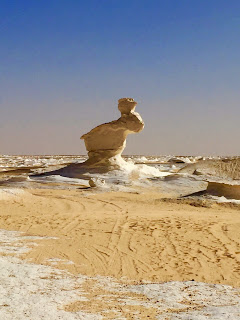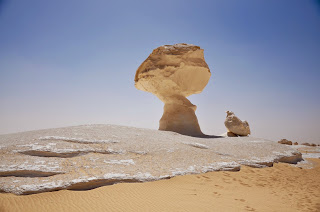This is the latest post in a series I’ve been doing about my recent journey through Egypt. If you’re interested in reading the other stories I’ve shared from that experience, you’ll find them here: Part 1 – Quiet and Calm in Cairo, Part 2 – The Great Pyramid of Giza, Part 3 –Abu Simbel, Aswan, and Luxor – the Other Ancient Wonders, and Part 4 – The Valley of the Kings and Queens – By Donkey!
As always, thanks to G Adventures for sponsoring this trip. If you find that you’d like to follow in my footsteps and do the same things that I did in Egypt, you can join their Absolute Egypt tour and experience it all yourself.
Over the first week or so of the journey through Egypt I visited a lot of ancient monuments, many of which I had seen the first time I visited the country more than a decade ago. Those monuments, which includes the Pyramids and Sphinx, the Temples of Luxor and Karnak, and the amazing Abu Simbel, are certainly awe inspiring and amazing to behold.
So, even though I had visited most of them in the past, it was refreshing to see them once again, particularly since crowds were nonexistent, providing a different experience. But, as the trip wore on, I was eager to see a side of Egypt that I hadn’t had a chance to experience just yet.
That came when at long last we left the well-worn tourist route, and made our way out into the desert. Here, we would see very few other travelers, but Egypt’s ancient wonders gave way to its natural beauty, which is fantastic in its own right.
The journey into the Sahara began by setting out bright and early from the city of Luxor to the small town of Dakhla Oasis. It is a long day on the road, broken up by a number of military checkpoints that stopped our vehicle often to check passports, search bags, and have a look at the travelers.
These checkpoints turn a long drive into a real slog, but they are necessary to maintain peace and security throughout the country. This leg of the journey was nothing compared to what would come later however, as the trip from Bahariya to Siwa would take nine hours to complete, with 34 checkpoints to pass along the way.
Arriving in Dakhla it was clear that we were far from the more tourist destinations that we had been visiting. This was rural Egypt, with few amenities for foreigners. The hotels and restaurants are simple, and there is little to do in the town itself. It was fascinating to see a different side of Egyptian life, but the village is not one you’d want to spend too much time in.

But Dakhla does provide access to an amazing natural setting. The nearby White Desert is a national park that spreads out for hundreds of kilometers across the Sahara. It gets its name from the chalk rock formations that cover the area, making it seem like their is snow covering the desert itself. Over the centuries the winds have carved those rocks into unique formations, creating a landscape filled with stone mushrooms, spheres, and even one shaped like a rabbit.
The White Desert is only accessible by 4×4, and we were led into by a team of excellent and knowledgeable guides from Egyptical Tours. They took us through some of the more interesting areas of this natural wonder, while giving us a glimpse of the natural forces that have shaped the landscape there.
All of Egypt is dry and warm of course, but the deep desert even more so. It was a challenge to stay properly hydrated while visiting this section of the country, despite the fact that we were constantly drinking water. The air is so dry there that any moisture evaporates very quickly, and even stepping into the shade of one of the many rock formations brought a noticeable change in temperature. It is a rugged, arid place that is captivating in its stark beauty. At times, it looks otherworldly, and it is a major contrast from the more popular tourist destinations that Egypt is known for.
Because the White Desert is a protected area, we were allowed to travel through it only at a cautious pace. The rock formations are fragile, and the Egyptian government is doing what it can to protect them. At one point, when we had stopped for lunch, a local ranger dropped by and sternly admonished our guides for parking one of the vehicles atop a rock formation. A fine was even issued – and paid – on the spot. Apparently they enforce the rules very sternly there.
After lunch we drove out of the White Desert and into a more open section of the Sahara. Here we were able to open up the engines on the 4×4’s and go plunging up and down some steep stand dunes. That brought a much appreciated jolt of adrenaline before we drove off into a remote corner of the desert that would serve as our campsite for the night.
While the guides went about setting up camp, the rest of us settled in on top of a towering sand dune and watch the sun set. The temperature dropped nicely as we watched, and the many hues of red, yellow, and orange that make up the landscape were on display nicely.
That evening was one of the true highlights of the entire Egyptian trip for me. Camping in the desert may have provided the best nights sleep I had on the entire trip. While most of the group huddled together near the vehicles, I grabbed my sleeping mat and bag, and dragged them off a short distance from the camp for a little solitude.
The quiet of the desert was simply wonderful, but not nearly as amazing as the night sky overhead. As the night wore on, the moon set behind the horizon, wrapping the Earth in darkness. But the sheer magnitude of stars overhead brought the Milky Way to life in stunning fashion. It was an impressive sight to say the least, and easily one of the best views of the heavens I have ever seen from any of the places that I have visited.
The next day we would break camp and head out on more desert adventure. We’d climb a few Egyptian “mountains” – a term I use very loosely – and explore other remote areas on our way to Bahariya Oasis. All of which was quite refreshing after the busy cities of Cairo, Luxor, and Aswan. But nothing could quite compare to that evening in the desert, which will stick with me for a long time to come. If you’re going to visit Egypt, it is definitely worth it to see if you too can camp out in the Sahara.
From here, our trip itinerary took us on to Siwa, which was another highlight of the journey. There is more to tell about that place, which is another destination travelers should make time for. It is a place that also contrasts sharply from the rest of the country, and I will share more of that in a future post.
- Gear Review: The Xero Scrambler Mid is an Ultralight Hiking Shoe for Spring - March 1, 2023
- Gear Review: Yeti Roadie 48 Wheeled Cooler - August 18, 2022
- Kristin Harila Continues Pursuit of 8000-Meter Speed Record - August 16, 2022

Such a nice post. Thanks for sharing with us. Egypt is an absolutely beautiful and in a wonderful location. It is an amazing place with such natural delights. I went through Egypt with the help of Explore Egypt and visited to the temple of Queen Hatshepsut, this unique temple reflects clear ideas about the serious conflict between Hatshepsut and her Nephew and son in low Tohutmosis III, since many of her statues were destroyed and most of her Cartouches were damaged by the followers of Tohutmosis III after the mysterious death of the queen. Such was great time. Keep blogging…